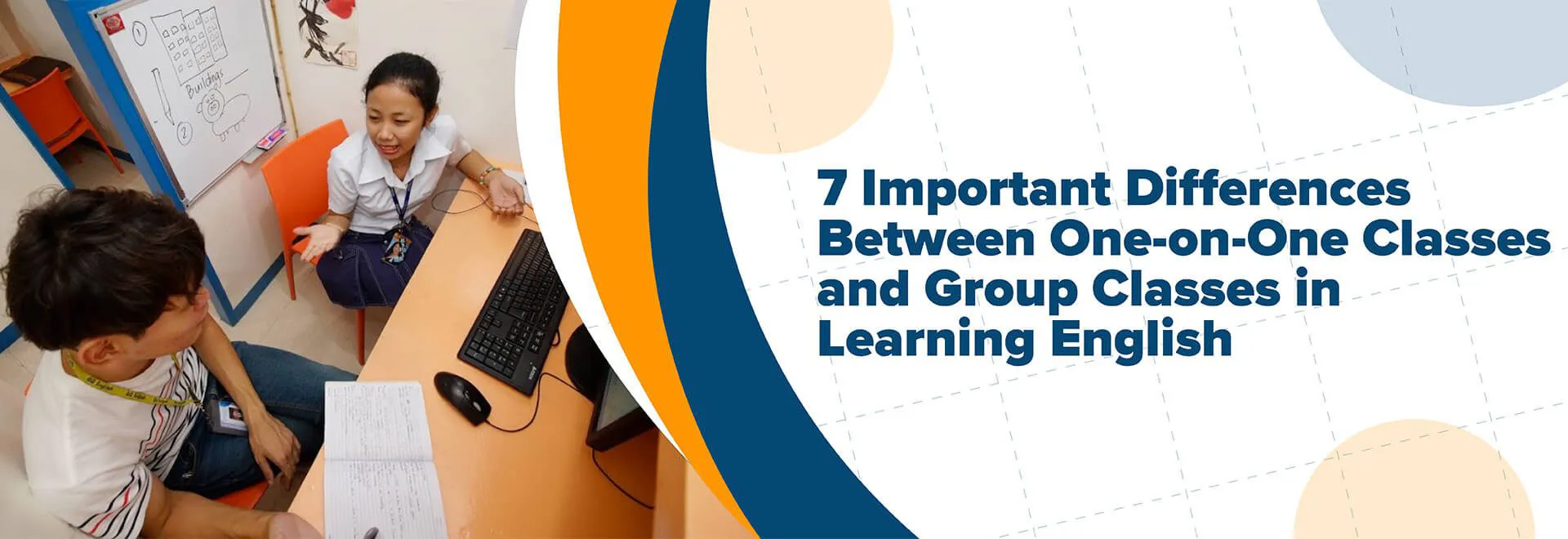
7 Important Differences Between One-on-one Classes and Group Classes in Learning English
Many language learners want to learn English quickly and conveniently. To achieve this, they study English at ESL schools, for example, in the Philippines and attend either a one-on-one class or a group class depending on their learning needs and preferences.
Obviously, you are here because you are a language learner and you want to improve your English skills. How would you want to learn English? Would you like to take a one-on-one class or a group class? This article will surely help you decide the best option for your learning goals.
7 Important Differences Between One-on-one Classes and Group Classes in Learning English

What is a one-on-one class?
In language learning, a one-on-one class is a learning set-up that involves two people interacting with each other. In one-on-one classes, there is a teacher and a student who are both engaged in the teaching and learning process.

What is a group class?
A group class involves many students and a teacher. In an ESL setting, a group class generally consists of a maximum of 10 students per class. ESL learners in this setup are usually from various countries where English is not the primary language.
What are the ultimate differences between one-on-one classes and group classes?
Language learners always have the option to study English according to their language learning needs. If you are confused about the kind of setup you intend to take in improving your English skills, you better continue reading this article and decide after. Check out the 7 main differences between one-on-one classes and group classes.
1. Task Management
One-on-one classes
In one-on-one classes, you do your tasks alone. Your teacher gives the task to you and you have to finish it without any help from another student, but you can ask for help from your teacher. You may do your task at your own pace in one-on-one classes, or do your own research based on your choice. Tasks given in one-on-one lessons are usually more difficult because you have to do them on your own and there is nobody to share your ideas with.
Group classes
In a group lesson, the tasks are usually shared by a group or by pair. If you belong to a group class, you can ask for help from your classmates and you can share ideas based on the given task. You can also share information about the topic or task you are doing, which makes it less difficult for you and your classmates to comply with it.
2. Student's Learning Preference
One-on-one classes
It is important that you know your learning goals and preferences. If you want to learn English with a private teacher or if you love studying alone, then a one-on-one class is the best option for you. The learning preference in one-on-one classes is more likely to be achieved because the teacher’s attention is focused only on you.
Group classes
If you want to get involved and engaged in the class, your ideal setup is a group class. In this setup, you may tend to be energized because some students create a fun atmosphere by cracking jokes or initiating small talks that would lead to a fun interaction in the lesson.
3. Speaking Practice
One-on-one classes
If one of your goals is to improve your speaking skills, a one-on-one class is likely to be your best option. Your talk time and interaction in one-on-one lessons are limited. Although you all have the chance to express yourself, the progress may not be quick. However, you will never be ashamed to share your ideas and opinions with your teacher. You can speak English as much as you want without thinking about being hesitant about making mistakes in grammar or pronunciation.
Group classes
You get all the opportunities to practice speaking English when you are in a group class. You will have the chance to practice it with other students, especially when they come from different countries. Progress may be a little quicker. In a group class, you are encouraged to talk about a certain topic, discuss a particular idea or concept, or provide more information about an open-ended question that your teacher asked.
4. Cost
One-on-one classes
A one-on-one class setup is more costly than a group class. If you do not think about saving money for the value of your learning, then you can choose to have a one-on-one class with a teacher. The cost sometimes varies from one platform to another. You can choose to study online or face-to-face. Online one-on-one classes may be a bit more expensive than face-to-face, but it depends on an ESL school that offers English lessons.
Group classes
If you are cost-conscious, then choose a group class. Compared to one-on-one lessons, it is much cheaper. In some offline schools, the fee is usually paid by the group and divided among the students who take this class.
5. Varying Proficiency Level
One-on-one classes
Your choice of the type of class to attend sometimes depends on the proficiency level you have. Many students have lower proficiency levels and opt to attend one-on-one classes to give focus on their English learning progress. If tracking your progress is your goal, then you can join a one-on-one lesson. It would be easy for you to check and evaluate your progress especially that you study alone in this kind of setup.
Group classes
The proficiency levels of students in a group class vary from one student to another. Sometimes in a group lesson, the students’ level of proficiency is not the same. Some of them have low levels and some have average levels. The downside of a group class in this situation is that not all students can understand the language and can express themselves clearly.
6. Class Progression
One-on-one classes
One of the downsides of a one-on-one class is the absence of the student. If you take one-on-one lessons and you are absent, your class with your tutor may not progress. Your learning on a particular day that you are absent may not be greatly at stake but your teacher has to adjust their lesson plan and topics.
Group classes
Compared to one-on-one classes, group classes may continue even if the number of students in that particular group is not complete. A group class may progress even with just one or two students.
7. Choice of Learning Style and Method
One-on-one classes
You can always agree with your teacher about how you want your learning to progress without risking your preferences. This is one advantage of a one-on-one class. Some students want to study on their own because they gain a lot of benefits from a one-on-one class. If you prefer personalized learning, you can create your own set of goals with your teacher and achieve them together.
Group classes
Some students do not prefer group classes for personalized learning because of some reasons. Group size, for example, is one factor because you cannot personally choose your learning style and method. Your teacher has already set targets for the whole class. Some of your classmates’ learning styles may also not align with yours.
It’s worth noting that the choice between one-on-one and group classes depends on your preferences, learning style, and specific educational goals. Both formats have their advantages and can be effective depending on the context and individual needs of each learner.
What is the best option?
Whether you study English online or face-to-face, it is important that you prioritize your learning needs and preferences. The best option depends on your target goals and methods to improve your English skills. There is no best learning setup when learning English, but based on the differences you have just read, you can decide whether you should take a one-on-one class or a group class. The choice is always yours!



